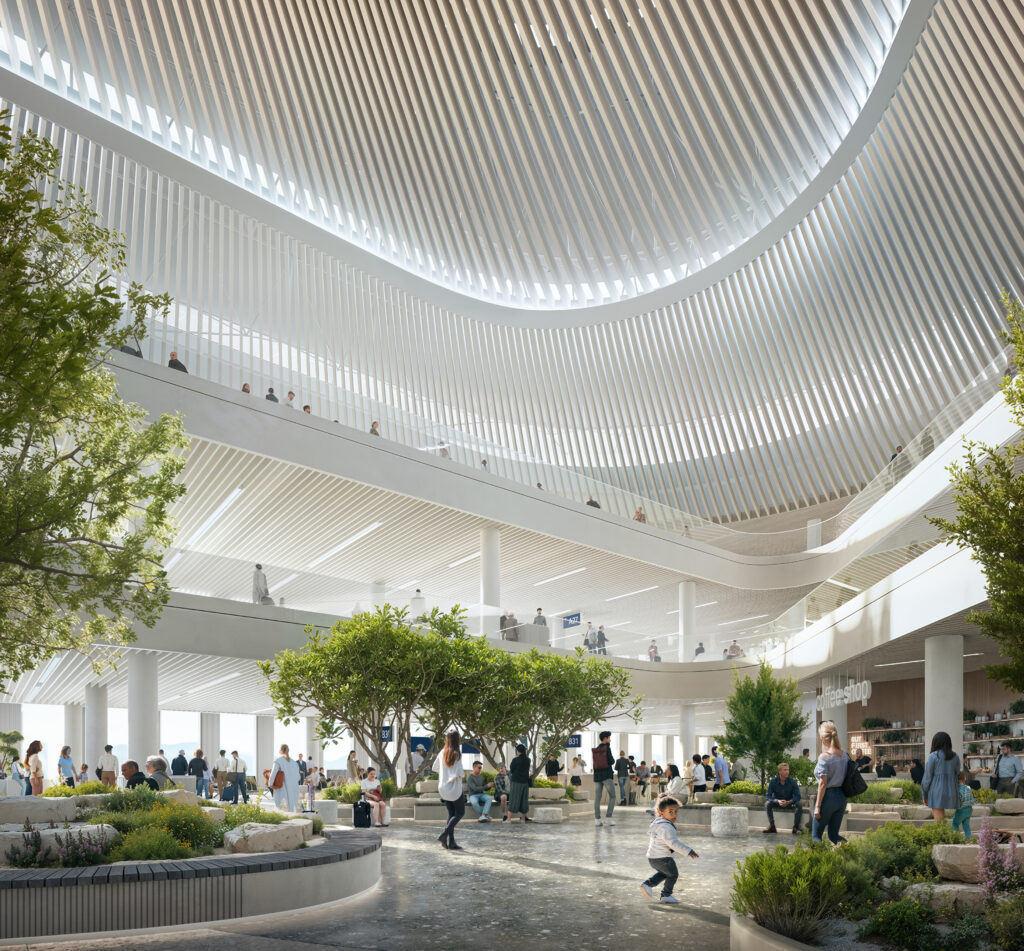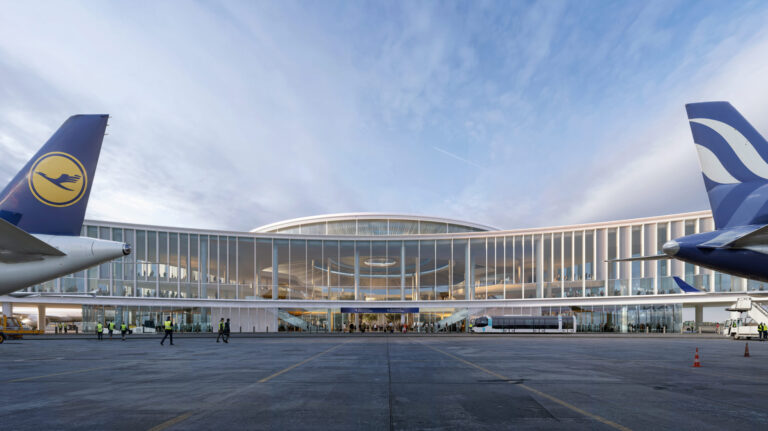The Anemos consortium, consisting of Grimshaw, Haptic, Athens-based K-Studio, Arup, Leslie Jones, Triagonal and Plan A, has been appointed to design the expansion of Athens International Airport (AIA). The project will increase the capacity of the airport from 26 million to 40 million passengers by 2032 through a phased program delivered within a live operational airport environment.
Originally designed and constructed by Hochtief and completed in 2001 ready for the Athens 2004 Summer Olympics, Athens International Airport is the largest airport in Greece, located 20 kilometer from the city center. The expansion project considers the current architectural context of the airport and proposes, within the masterplan brief, extensions and alterations to the main terminal building (MTB) and satellite terminal building (STB). The scope also includes landside and airside updates, aircraft stands, gate seating and commercial areas.
Unifying the existing airport with the new elements is central to the design concept: an airport that reflects the past, present and future of the city. This will be guided and informed by a response to the spirit of Athenian life, the architecture and materiality of Athens, and the celebration of a city that is ingrained with layers of time.
Pragmatic in layout, securing an ease of operations, efficient flows and intuitive wayfinding, a sense of place will pervade, with a rich landscaping strategy, cohesive and natural materials palette, and an infusion of daylight to all parts of the terminal building.
The expansion will also build on AIA’s net zero operations target and whole life carbon commitments, adopting passive design principles, low-carbon structures and materials, modular efficient construction systems, and renewable energy, waste and water systems. The project is targeting a LEED Gold standard.
Running on a north to south axis, the design for the MTB includes a new landside identity to the west. A distinct, repetitive and modular façade, creating a ‘lifted’ internal colonnade, will be defined by stone vertical fins extending across the structure. Intersecting this rhythm will be six new portals – contemporary and light but distinct stone forms – providing an order and scale that will direct and welcome passengers to the new check-in/departures hall. In the hall, the soffit will also be lifted, diffusing daylight deep into the busy transitional space and prioritizing passenger navigation, flow and access.

Two new parts of the design that reflect Athenian culture and heritage are the north and south oculus, which will be destination points and dwelling spaces, extending the existing structure and accessed via active, flowing, rhythmic street spaces, balconies, VIP lounges and commercial zones.
The north oculus will be the primary space, a rich landscaped Mediterranean garden set in a 24.5m-high circular, tiered space – a volume that at once impresses and grounds the experience of the terminal and the city beyond. Entering the northern oculus from airside at ground level, passengers will experience a microcosm of city life – the hospitality of Athens – a memorable moment with an architectural language that flows and leads the eye to specific environments across the MTB.
The south oculus will be a further dwell area, where three terraced levels will be arranged around an atrium space with generous seating and extensive landscaping alongside smaller F&B units to create a unique and memorable experience. Again, through a lifted soffit, daylight will be diffused across the space, providing long views across the terminal and navigation toward the departure gates.
As part of the design proposals, the STB will change function to become a dedicated Extra Schengen facility with significant operational and spatial modifications. Linked to the MTB via a tunnel, the passenger circulation areas of the building will be substantially improved, including the integration of atrium space which, following the principles of the MTB, brings daylight into the function of these spaces, ultimately enhancing the passenger experience.
The strategy for delivery across the terminal buildings emphasizes a program of modification and extension that will be transformative, while minimizing disruption to the existing facilities.
DESIGN TEAM
Client: Athens International Airport
Architect: Grimshaw, Haptic and K-Studio
Engineer:Arup
Retail design consultant: Leslie Jones
Wayfinding: Triagonal
Design management: Plan A
“The Anemos team was brought together by its shared values, approach and purpose and combines deep local knowledge and international expertise in the design and delivery of complex infrastructure and aviation projects,” commented Conor Hoey, Europe aviation business leader, Arup. “As world leaders in aviation design, Arup is proud to bring its advanced approach – integrating energy, digital technologies, sustainability and user-centred design – to the team. This win is a testament to the AIA’s trust in us to support it in reaching its full capacity with a fresh, innovative and passenger-focused experience that will exceed the highest standards of aviation excellence.”
Cormac Deavy, project director and UKIMEA property, science and industry business leader, Arup, added, “I am delighted to be leading the Arup team in providing all the technical and engineering services required to deliver this transformational project, as an integral part of the Anemos consortium. Synthesizing the different technical inputs in an integrated way, while blending the old with the new, will be essential as we deliver this project that has sustainability at its heart.”


